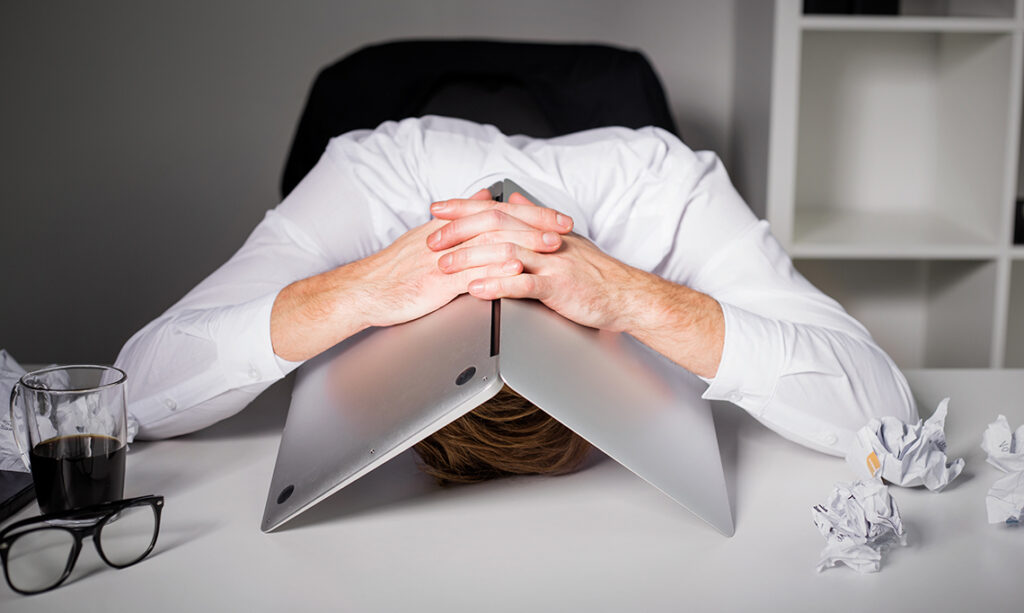In this video Dr. Kate Truitt unpacks the emotional symptoms of burn out and how it differs from depression and anxiety. Understanding the nuances of burn out is crucial for creating an action plan to prevent burn out as well as designing a burn out recovery journey. Knowledge is power – come learn about burnout and how it impacts your mind and body. Then, learn some hacks to stop burnout from taking over your life.
Protecting against burnout or sponsoring your burnout recovery means setting healthy boundaries with your time at the end of each day. In these days of remote working it can be even harder than usual to transition the day from work to play. Join Dr. Kate Truitt in learning how to incorporate the Self-Havening Touch plus CPR for the Amygdala (let’s Create Personal Resiliency!) to help your brain know the time to drive and work hard is over and the opportunity for rest and rejuvenation is upon you.
Emotions exist in our life to teach us about ourselves and the world around us. In this guided meditation Dr. Kate Truitt will help you learn more about your specific worries or concerns and connect with your internal wisdom.
When we’re burned out, even the smallest intrusion on our time can activate a trigger response of annoyance, frustration, overwhelm, and even fatigue or depressive symptoms. Join Dr. Kate Truitt to unpack why this happens in our mind and body and to learn a quick technique called CPR for the Amygdala to reduce reactivity and even HEAL your mind and body back into a balanced and empowered state of homeostasis.
by Dr. Kate Truitt
You yourself, as much as anybody in the entire universe, deserve your love and affection.
—Buddha
Have you been feeling lately like you’re not living up to the expectations you have for yourself in your professional and personal life? Do you feel you are losing some of your former optimism? Are you feeling less excitement and engagement when faced with challenges than you did before?

In our practice we have been talking a lot with our patients about these types of feelings, because people seem to be experiencing them more often. You might chalk it up to pandemic anxiety, or be concerned that you might be suffering from depression. Having some of these feelings may make sense to you, given the mind-numbing times we are in now, but beware—they could be warning you that you are heading toward burnout.
To determine whether you are susceptible to, or already experiencing burnout, it is important to understand what burnout is, because although it can masquerade as anxiety and depression, it’s in a space of its own. Burnout is not something that quickly takes over your mind. It is a gradual process that escalates over time, and one of its core causes is chronic stress.
The World Health Organization calls burnout an “occupational phenomenon,” and defines it this way:
“Burnout is a syndrome conceptualized as resulting from chronic workplace stress that has not been successfully managed. It is characterized by three dimensions: feelings of energy depletion or exhaustion; increased mental distance from one’s job, or feelings of negativism or cynicism related to one’s job.”
The big takeaway in that definition is that burnout is stress that has “not been successfully managed.” In this article I hope to help you with that successfully managing stress part, looking through the lens of our new reality of working from home. And a note about this definition before I continue: Because of the Coronavirus Pandemic I want to broaden that WHO definition to make it more than merely an “occupational phenomenon,” to encompassing not only workplace burnout, but isolation burnout or more broadly, Coronavirus burnout. These are unprecedented times, and as pressures in our external environment rise—our internal environment is going to change too. Stress, worry, uncertainty, and fear about the world we live in does not stop at the threshold to our homes—it infiltrates it.
First, let’s look at whether you are susceptible to burnout. I have a list of three questions that can help people move toward the answer to that. Take a few moments to think about these:
1. Have your diet, drinking (think alcohol) and exercise habits changed over the past few months, and have your feelings about these different behaviors changed lately? I ask this in a two-part way because changes in your frame of mind can get at the “why” of what you’re feeling.
2. Are you working longer or shorter hours than you were before, and how do you feel about the time you are committing to work—has your productivity gone up or down?
3. Do you notice an emotional reaction or shift when you get notifications from work, such as increased stress from a text message, email or a slack notification?
Thinking about some of these questions may have set off an alert for you, if not a red alert, then maybe a yellow one. If that is the case, take another look at the list above and write down three things you would do differently related to those issues. Try to identify some opportunities to make a positive shift in what has been happening. You don’t have to feel pressure to act on them; getting them out in the open is the most important thing at first.
That first exercise helped you understand whether you are on the way to being burned out. Next, let’s try to determine whether you are actually suffering from the effects of burnout. For this, I want you to consider five areas of questions:
1. How do you feel about each day? Do you wake up with optimism?
2. Each day, do you feel like you do at least one thing that matters to you and the world around you, and do you receive acknowledgment for your contribution from yourself or others. (Yes, your own acknowledgment is very important too! I’ll address that in a moment.)
3. How is your sleep? Do you feel emotionally or physically fatigued? Are you often ruminating at night? Have you set any boundaries in place to ensure you sleep well?
4. How motivated are you? Has your interest, excitement, or engagement changed? Do things that used to perk you up still perk you up?
5. Do you care about the things you’re doing? Do you feel that your work has meaning or that it matters?
If you answered any of these questions differently than you would have one year ago you may be on the road to burnout. They are meant to assess your emotional well-being and meaning-making (how you personally perceive your world), which are core tools that protect against burnout.
If you are frequently feeling gloomy, like life and work (and you) are burdensome and feel constantly overwhelmed, it is time for you to do something. So, let’s see look at some little self-compassion and self-care hacks to help you.
Optimism is one of the first things that starts to leave us as burnout takes hold, which is why our first question above is so important. Now, I admit that it is unrealistic for most of us to swing our feet onto the floor and leap out of bed, excited to meet every new day. That’s because many of our days are fraught with challenges. When our brains are functioning normally, we see challenges as exciting and as opportunities for growth, but as we slide down the burnout scale, we begin to lose the ability to look for and grasp those opportunities.
A little exercise I would like you to try at the end of your day is to recall a few bright spots, or positive moments in your day. It could be a smile, birds chirping, or sharing a laugh with a colleague. No matter how you are feeling, there should be some point in your day you can recall in a positive light. Find it, and then stop for a moment and focus on it, anchoring it in your mind and body. Share with yourself why it made you feel good and hopeful.
By being in touch with our emotional world and intentionally finding positive moments, we can create moments of optimism. These can lead to finding opportunities for overcoming challenges.

One of the most important issues in burnout deals with the boundaries between our professional lives and personal lives. Nobody can completely disconnect the two, nor should they try. The personal and professional parts of our lives are intertwined, and both together make up who we are as people, but they both need to have their own spaces. That has been made a bit more difficult as millions of us have adjusted (or not) to working from home.
Back in our old pre-pandemic “real world,” we were better able to create a clear delineation between our work time and personal time. A 30-minute commute works wonders with that issue—you get in the car, drive to work and start working somewhere else, and when you are done with your workday, you get in the car and drive home. Still, those who experienced burnout in the old real world tended to rideshare their workplace stress and problems home with them on the evening commute, but at least they had some of the benefit of that physical act of separation.
That’s gone now.
Or is it?
Not if we can purposefully make that separation happen in our new real world. And this includes separating in not only space, but in time as well.
First and foremost, people who are working from home need to be serious about creating a clear, scheduled structure that allows the brain to delineate work time from personal time. The clear distinction between the two mindsets is a requirement for emotional health and well-being and will help protect against burnout. If we don’t have that separation, our brain feels like we are chronically “on.” A part of the separation also means plenty of time when screens are down and there is no more exposure to the news. A lot of our patients are becoming numb from chronic exposure to news reports and that simply results in increased risk for burnout as well as higher levels of stress and anxiety.
You can learn more about creating those delineations in our comprehensive Telecommuting series and our Burnout series on the Dr. Kate Truitt & Associates You Tube Channel
Finding those bright spots in your day, making time for yourself, creating space between your work areas, and looking for opportunities to make positive shifts in your life are all part of putting the power of self compassion to work. Be curious about what’s going on in your internal world. Spend moments being present with yourself. Acknowledge your accomplishments, and give yourself some grace when you fall down. Prioritize little things that are not such little things, like sleep, eating well, and giving your brain and body a rest from screens and the noise around you.
Self-compassion may be a new term for you. It’s not something often taught through the rigors of daily life, but the idea behind putting self-compassion into practice is simple: Treat yourself with the loving kindness, the care, the grace and forgiveness with which you treat those you love the most in your life.
———————————
Federal Department of Consumer Affairs and Board Of Behavioral Science Notifications For Consumers